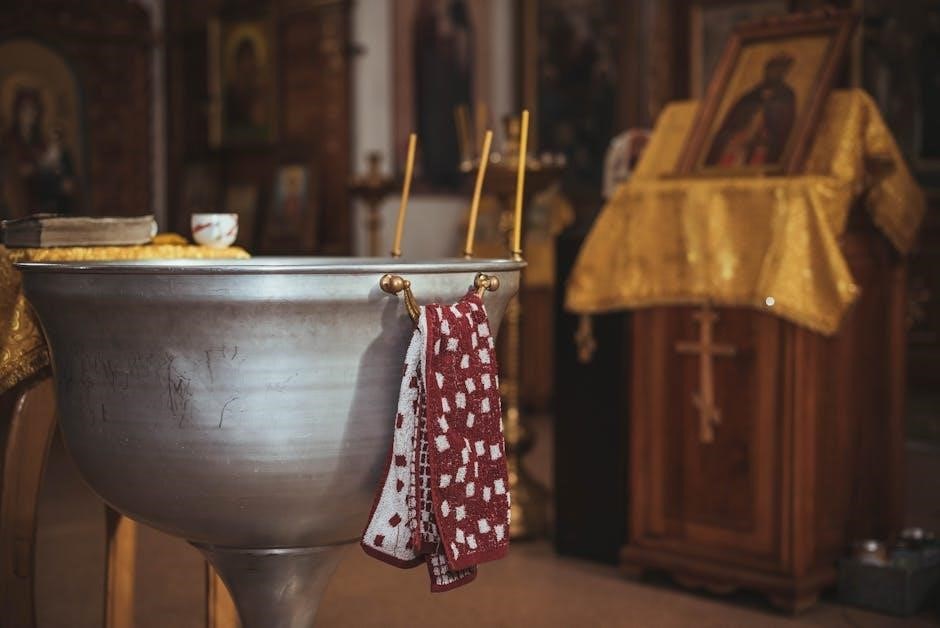The iconostasis is a sacred barrier adorned with icons, serving as a visual and spiritual bridge between the nave and the altar in Orthodox churches, symbolizing divine presence.
1.1 Definition and Purpose of the Iconostasis
The iconostasis is a sacred barrier adorned with icons, serving as a decorative and spiritual divider between the nave and the sanctuary in Orthodox churches. Its primary purpose is to create a visual and symbolic bridge between the heavenly and earthly realms, enhancing the mystical experience of worship. Adorned with icons arranged in a specific order, the iconostasis visually teaches Orthodox theology and the lives of saints, while its doors, such as the Holy Doors and Deacons’ Doors, play a central role in liturgical practices. This structure not only separates the clergy’s area from the congregation but also unites them through the shared focus on the icons and the sacred rites beyond.
1.2 Historical Context and Evolution
The iconostasis has its roots in early Christian practices, evolving from a simple curtain or low screen separating the altar from the congregation. By the Middle Byzantine period, it developed into a multi-tiered structure adorned with icons, reflecting the deepening of liturgical and theological practices. The iconostasis reached its characteristic form during the 14th to 16th centuries, symbolizing the bridge between heaven and earth. This evolution mirrored the Church’s growing emphasis on the mystical and the sacred, embedding the iconostasis as an integral part of Orthodox worship and identity.
Historical Evolution of the Iconostasis
The iconostasis transformed from a simple barrier in early Christian times to a multi-tiered screen, reflecting liturgical and cultural developments across centuries, blending tradition with modern aesthetics.
2.1 Early Beginnings: From a Simple Barrier to an Icon Screen
The iconostasis originated in early Christian churches as a modest screen separating the nave from the altar. Initially, it was a simple barrier, often made of cloth or wood, serving practical and symbolic purposes. Over time, it evolved into a multi-tiered structure adorned with icons, becoming a central element in Orthodox worship. The early iconostasis reflected the need to visually and spiritually connect the congregation with the divine, while maintaining the sacredness of the altar. This transformation marked the beginning of its development into the elaborate icon screens seen today, blending functionality with theological significance. The progression from a humble barrier to a richly decorated icon screen highlights the iconostasis’s enduring role in Orthodox liturgy and spirituality.
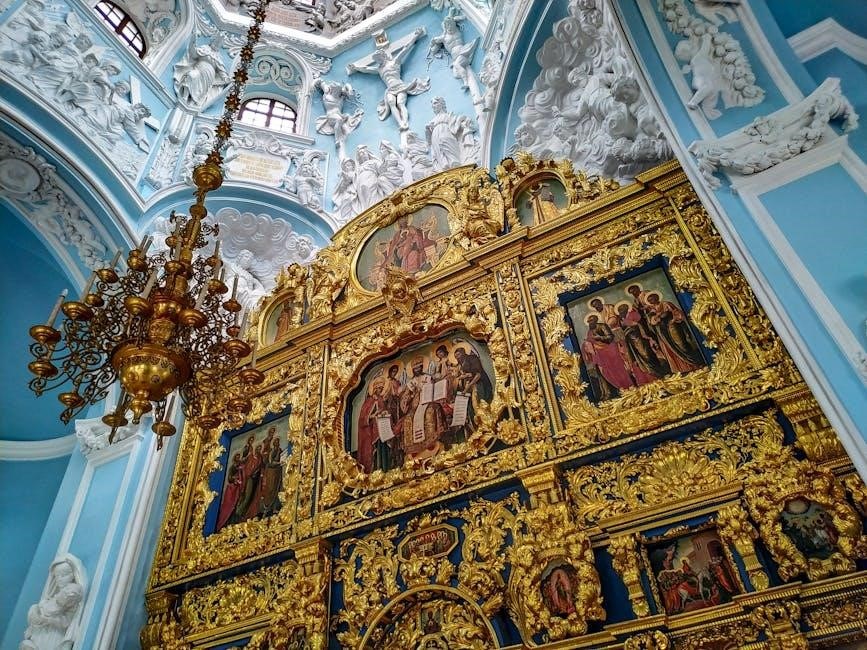
2.2 The Middle Byzantine Period: Development of the Multi-Tiered Iconostasis
During the Middle Byzantine Period, the iconostasis underwent significant transformation, evolving from a simple screen into a multi-tiered structure. This development reflected the growing importance of icons in Orthodox worship and theology. The multi-tiered design emphasized hierarchy and the mystical connection between heaven and earth. Icons were arranged in specific tiers, with the lower tier often depicting Christ, the Virgin Mary, and prominent saints, while upper tiers represented biblical scenes and feasts; The use of gold and vibrant colors symbolized divine light and transcendence. This period also saw the standardization of icon placement, aligning with liturgical practices and theological teachings. The multi-tiered iconostasis became a hallmark of Byzantine churches, blending artistry with spirituality and reinforcing the iconostasis’s role as a visual and symbolic bridge between the congregation and the sacred altar. This design laid the foundation for later innovations in Orthodox churches.
2.3 The Russian Influence: Unique Styles and Innovations
The Russian influence on iconostasis design introduced unique styles and innovations, blending traditional Byzantine elements with distinct Russian aesthetics. During the 16th century, under the patronage of figures like Ivan the Terrible, Russian workshops began creating elaborate multi-tiered iconostases adorned with intricate carvings and gold leaf. The Moscow and St. Petersburg schools became renowned for their craftsmanship, often incorporating local materials and techniques. These iconostases featured vibrant colors and ornate details, reflecting Russian spirituality and cultural identity. The royal doors, often decorated with biblical scenes, became a central focal point. Regional variations emerged, with some churches adopting baroque influences in the 17th and 18th centuries. This period marked a flourishing of iconostasis art, making it a defining element of Russian Orthodox churches and a testament to the nation’s rich liturgical and artistic heritage.
2.4 Modern Trends in Iconostasis Design
Modern trends in iconostasis design reflect a blend of tradition and innovation, adapting to contemporary aesthetics while preserving sacred symbolism. Many contemporary designs emphasize simplicity and minimalism, often using clean lines and lighter materials to create a sense of openness. At the same time, traditional multi-tiered structures remain popular, with modern artisans incorporating new techniques such as 3D printing and laser engraving to achieve intricate details. Some churches now opt for portable or modular iconostases, especially in smaller spaces, allowing for flexibility in worship settings. Additionally, there is a growing interest in ecumenical designs that incorporate elements from various Orthodox traditions. Despite these innovations, the core theological and liturgical significance of the iconostasis as a spiritual bridge remains unchanged, ensuring its continued relevance in modern Orthodox worship.
Composition and Structure of the Iconostasis
The iconostasis is a multi-tiered structure adorned with sacred icons, central doors, and symbolic imagery, serving as a bridge between the nave and the sanctuary.
3.1 The Multi-Layered Meaning of the Iconostasis
The iconostasis holds profound spiritual and symbolic significance, serving as a visual and theological bridge between the earthly and heavenly realms. Its multi-tiered structure represents the hierarchy of divine order, with each level dedicated to specific sacred themes. The lowest tier, often depicting Christ, the Virgin Mary, and the patron saints, connects the faithful to the divine. Above, the Deesis tier portrays the Last Judgment, emphasizing prayer and intercession. Higher tiers symbolize the celestial realm, with angels and biblical figures. The use of vibrant colors, gold, and intricate designs reinforces its sacred nature. The iconostasis is not merely a decorative screen but a dynamic tool for liturgical worship, teaching Orthodox theology through imagery, and fostering a sense of awe and spiritual connection among worshippers. Its design reflects the unity of heaven and earth, making it a cornerstone of Orthodox liturgical practice.
3.2 The Sovereign Tier: Central Icons and Their Significance
The Sovereign Tier, the lowest and most prominent level of the iconostasis, is central to Orthodox worship and spirituality. It typically features the icon of Christ Pantocrator on the north side and the Theotokos (Mother of God) on the south, symbolizing their eternal intercession. The Royal Doors, adorned with images of the Annunciation, stand at the center, representing the gateway to the Kingdom of God. These icons are arranged in a specific order, reflecting the Incarnation and humanity’s reconciliation with God. The Sovereign Tier serves as a visual narrative of salvation, connecting the faithful to the divine. Its central placement emphasizes the importance of these icons in liturgical life, fostering devotion and contemplation among worshippers. This tier is not only a decorative element but a theological foundation, grounding the congregation in the mysteries of the faith.
3.3 The Deesis Tier: Depictions of the Last Judgment and the Mother of God
The Deesis Tier, situated above the Sovereign Tier, is a central element of the iconostasis, typically depicting the Mother of God, Christ Pantocrator, and John the Baptist in a grand supplication. This tier is often referred to as the “Great Deesis,” emphasizing the intercession of the saints and the Mother of God for humanity’s salvation. Flanking these central figures are icons of apostles, prophets, and other saints, arranged in hierarchical order. The Deesis Tier symbolizes the unity of heaven and earth, with the saints and the Mother of God pleading on behalf of humanity. It also reflects the Orthodox belief in the intercession of the righteous and the ultimate hope of salvation. This tier visually connects the divine with the earthly, reinforcing the eschatological themes of the Last Judgment and the Second Coming. Its arrangement serves as a reminder of the divine order and the mystical unity of the Church.
3.4 The Festal Tier: Celebrating Major Orthodox Feasts
The Festal Tier is one of the upper levels of the iconostasis, dedicated to depicting major Orthodox feasts and their theological significance. This tier typically includes icons of the Nativity, the Baptism of Christ, the Transfiguration, and the Dormition of the Mother of God, among others. These icons are arranged chronologically, visually narrating the Gospel story and the mysteries of salvation. The Festal Tier serves as a visual reminder of the Church’s liturgical cycle, connecting the faithful to the divine events celebrated throughout the year. Its vibrant colors and dynamic compositions emphasize the joy and solemnity of these feasts, while also reinforcing the theological themes of redemption, light, and theosis. This tier plays a crucial role in the liturgical experience, helping believers contemplate the mysteries of the faith.
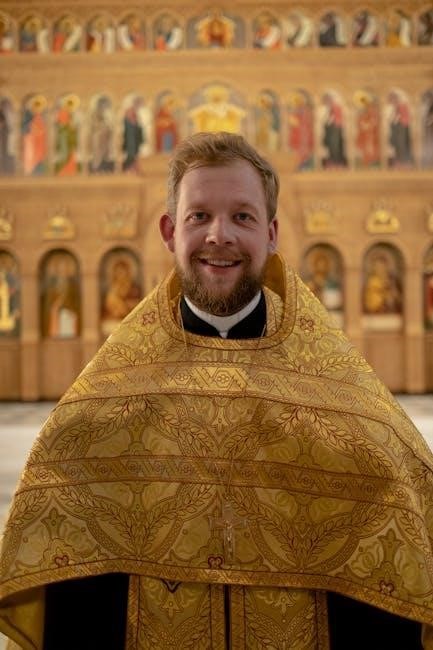
Iconostasis Design and Artistry
The iconostasis showcases exquisite craftsmanship, blending theology with artistic expression. Intricate carvings, gilding, and vibrant icons reflect divine beauty, creating a harmony of form and spiritual meaning.
4.1 The Role of Icons in the Iconostasis
Icons in the iconostasis are more than decorative elements; they are sacred gateways to the divine. Each icon serves as a visual narrative of biblical events, saints, and theological truths, educating the faithful and inspiring devotion. Placed in a specific hierarchical order, they guide worshippers’ prayers and reflections. The icons are not mere images but living symbols that connect the earthly and heavenly realms, embodying the Orthodox belief in theosis. Their presence in the iconostasis transforms the space into a sacred environment, facilitating spiritual contemplation and participation in the liturgy; Through their veneration, believers express reverence for the holy, acknowledging the iconostasis as a bridge between the material and the mystical. This tradition upholds the icon’s role as both a teaching tool and a means of spiritual communion.
4.2 Symbolism in the Iconostasis: Colors, Gestures, and Imagery
The iconostasis is rich in symbolism, with colors, gestures, and imagery conveying theological truths. Gold represents divine light, red symbolizes martyrdom, and blue signifies purity. Gestures like the Virgin Mary’s prayerful hands and Christ’s blessing hand emphasize intercession and benediction. Imagery is structured hierarchically: the Sovereign tier features key icons, the Deesis tier portrays the Last Judgment, and upper tiers depict biblical feasts. These elements create a visual narrative that reinforces Orthodox theology and enhances spiritual engagement. The combination of these symbolic elements fosters a deeper understanding of the divine, making the iconostasis a powerful tool in worship and spiritual reflection.
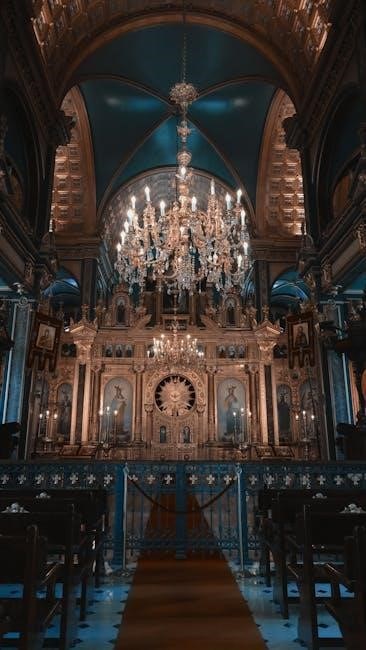
4.3 The Importance of the Royal Doors and Side Doors
The Royal Doors, centrally located on the iconostasis, hold profound significance as the primary passageway for clergy during liturgical processions. Adorned with icons of the Annunciation, they symbolize the gates of heaven and the entrance to the Kingdom of God. These doors are opened during key moments in the liturgy, such as the Great Entrance, when the Holy Gifts are carried out. The side doors, often depicting archangels, are used by deacons and lower clergy for liturgical movements. Both sets of doors are rich in symbolism, representing the boundary between the sacred and the profane. Their careful use emphasizes the hierarchical and mystical nature of Orthodox worship, bridging the earthly and heavenly realms. This physical and spiritual threshold underscores the iconostasis’s role as a divider and connector in the liturgical space.
4.4 Architectural Variations Across Orthodox Traditions
The iconostasis varies significantly across Orthodox traditions, reflecting regional architectural styles and cultural influences. In Greek Orthodox churches, the iconostasis often features a more restrained design with gilded details and a focus on central icons. Russian Orthodox tradition, however, is known for grand, multi-tiered iconostases with intricate carvings and vibrant colors. Other traditions, such as Ukrainian or Romanian, blend local craftsmanship with Byzantine influences, resulting in unique designs. The materials used, from wood to marble, also differ based on regional availability and aesthetic preferences. These variations highlight the adaptability of the iconostasis while maintaining its core spiritual and liturgical functions. Despite differences, each tradition preserves the iconostasis’s role as a sacred divider and visual narrative of Orthodox theology. This diversity enriches the universal Orthodox identity while reflecting local cultural and artistic expression.
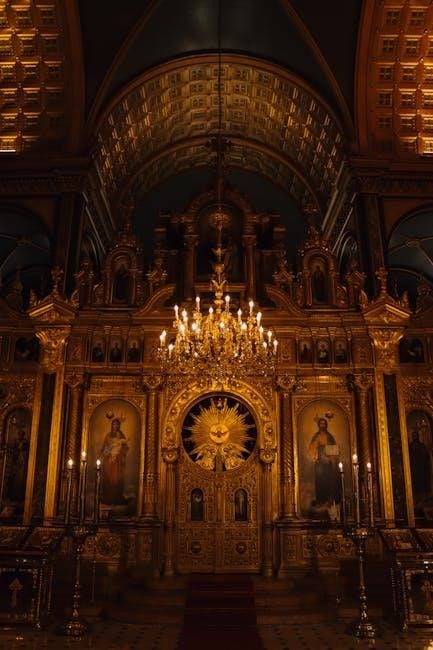
Theological and Spiritual Significance
The iconostasis serves as a bridge between heaven and earth, symbolizing the veil between the nave and altar, and uniting the faithful with Christ in liturgy.
5.1 The Iconostasis as a Bridge Between Heaven and Earth
The iconostasis is a sacred barrier that serves as a visual and spiritual bridge between the material and divine realms. It symbolizes the connection between heaven and earth, embodying the unity of the celestial and terrestrial liturgy. The multi-tiered structure, adorned with icons of Christ, the Virgin Mary, and saints, represents the heavenly hosts and the intercession of the Mother of God. The Royal Doors, often decorated with the Annunciation, signify the threshold between the nave and the altar, where the mysteries of salvation are enacted. Through its imagery and rituals, the iconostasis fosters a profound sense of the divine presence, drawing worshippers into the mystical liturgy and the eternal kingdom. This sacred screen is not just a physical barrier but a theological gateway to the heavenly realm.
5.2 The Veil Between the Nave and the Altar
The iconostasis serves as a sacred veil separating the nave, where the faithful gather, from the altar, the most sacred space in the church. This separation symbolizes the boundary between the earthly and divine realms, reminiscent of the veil in the Temple of Jerusalem. The iconostasis acts as both a physical and spiritual partition, creating an atmosphere of reverence and mystery. Its doors, particularly the Royal Doors, are opened during key moments of the liturgy, such as the Great Entrance, to reveal the altar and symbolize the revelation of divine truths. This eucharistic dynamic underscores the iconostasis’s role in bridging the two spaces while maintaining their distinct sacredness. The veil thus prepares the faithful to approach the mysteries of God with awe and spiritual readiness.
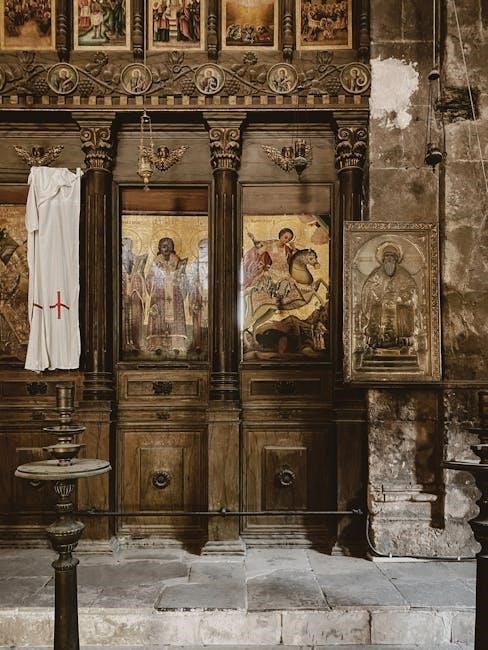
5.3 The Iconostasis and the Mystical Liturgy
The iconostasis is deeply intertwined with the mystical dimensions of the Orthodox liturgy, embodying the church’s liturgical theology. Icons on the iconostasis depict sacred events, saints, and divine beings, creating a visual narrative that immerses worshippers in the sacred story. The screen’s design, with its multiple tiers, reflects the hierarchy of heaven and the celestial order of worship. During the liturgy, the opening and closing of the Royal Doors symbolize the revelation and concealment of divine truths, drawing the faithful into the mystical reality of the Eucharist. The iconostasis thus serves as both a physical and spiritual mediator, guiding the congregation through the liturgical journey and fostering a profound sense of communion with the divine.
5.4 The Iconostasis as a Symbol of Hierarchy and Order
The iconostasis embodies the hierarchical structure of the Orthodox Church, reflecting both divine and earthly order. Its multi-tiered design represents the celestial hierarchy, with icons arranged in a specific sequence to symbolize the ranks of saints, angels, and divine beings. The Sovereign Tier, often depicting Christ, the Virgin Mary, and John the Baptist, signifies the highest level of authority. Below it, the Deesis Tier portrays the Last Judgment, emphasizing the ultimate accountability of humanity. This arrangement reinforces the liturgical order and the clergy’s role as mediators between the divine and the faithful. The iconostasis thus visually enforces the church’s hierarchical structure, guiding worshippers to reverence and humility through its symbolic representation of the divine order.
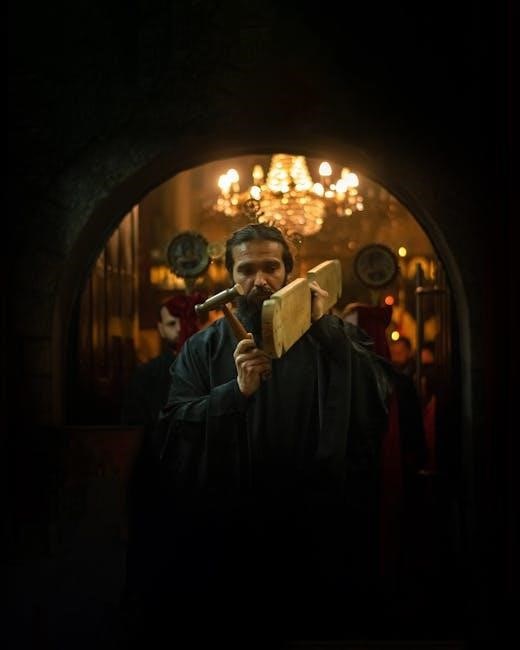
Cultural and Liturgical Impact
The iconostasis profoundly influences Orthodox identity, serving as a visual and spiritual educator, while its presence enriches liturgical worship, reflecting the church’s cultural and theological heritage.
6.1 The Iconostasis in Orthodox Worship and Spirituality
The iconostasis holds a central role in Orthodox worship, serving as a spiritual focal point that connects the congregation to the divine. It is adorned with icons that depict sacred figures and events, guiding worshippers in prayer and contemplation. During liturgical services, the iconostasis is often illuminated, creating a mystical ambiance that enhances the spiritual experience. The arrangement of icons follows a hierarchical order, reflecting the theology of the Orthodox Church and emphasizing the unity of heaven and earth. Worshippers venerate the icons, expressing reverence for the saints and the Mother of God, while the Royal Doors symbolize the entrance to the Kingdom of Heaven. Through its presence, the iconostasis fosters a sense of awe and devotion, deepening the spiritual connection of the faithful during worship.
6.2 The Role of the Iconostasis in Teaching Orthodox Theology
The iconostasis plays a vital role in teaching Orthodox theology through its visual representation of sacred themes and hierarchical arrangement. It serves as a catechetical tool, conveying complex theological concepts in an accessible manner. The icons depict key events and figures, such as the Incarnation, the Virgin Mary, and the saints, reinforcing the narrative of salvation. The placement of icons follows a theological hierarchy, with Christ and the Mother of God at the center, emphasizing their central roles in Orthodox belief. This visual structure helps worshippers understand the relationship between heaven and earth, the communion of saints, and the mysteries of the faith. The iconostasis thus functions as both a decorative and educational element, deeply rooted in Orthodox tradition, making it an essential medium for transmitting theological truths to the faithful.
6.3 The Iconostasis as a Reflection of Orthodox Identity
The iconostasis stands as a defining feature of Orthodox churches, visually representing the unique identity and spiritual traditions of the Orthodox faith. It serves as a unifying element across Orthodox communities, reflecting shared beliefs and practices. The intricate design and arrangement of icons emphasize the veneration of saints, the Virgin Mary, and the Trinity, distinguishing Orthodox worship from other Christian traditions. The iconostasis also embodies the cultural and historical richness of Orthodoxy, with its evolution influenced by Byzantine and regional artistic styles. Its presence in every Orthodox church underscores its role in preserving the faith’s continuity and heritage. Thus, the iconostasis is not only a liturgical fixture but also a powerful symbol of Orthodox identity, bridging the sacred and the communal.
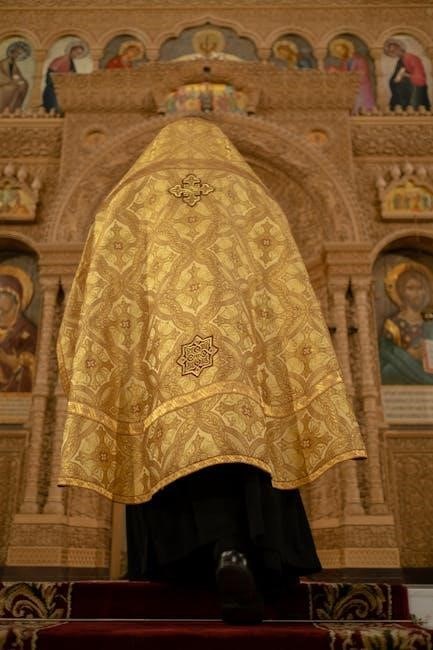
Practical Aspects of the Iconostasis
The iconostasis requires careful construction and maintenance, ensuring durability and preservation of its sacred icons. Regular upkeep involves polishing, dusting, and restoring icons to maintain their vibrancy and spiritual significance.
7.1 Construction and Maintenance of the Iconostasis
The construction of the iconostasis involves skilled artisans who carefully craft the wooden structure, often adorned with gilded details, to house the sacred icons. Traditional materials like wood, gold, and tempera paints are used to ensure durability and aesthetic harmony. Maintenance is a sacred duty, requiring regular polishing of the gold leaf and dusting to preserve the icons’ vibrancy. Icons are periodically restored by trained professionals to maintain their spiritual and artistic integrity. The process is deeply rooted in Orthodox tradition, emphasizing the importance of preserving both the physical and spiritual aspects of the iconostasis. This meticulous care reflects the reverence with which the Orthodox Church holds its iconostasis, ensuring it remains a focal point of worship and devotion.

7.2 The Placement of Icons and Their Veneration
The placement of icons on the iconostasis follows a precise order, reflecting theological and liturgical significance. Icons are arranged in tiers, with the lower row often depicting Christ, the Virgin Mary, and patron saints. The deesis tier above represents the Last Judgment, while the festal tier illustrates major Orthodox feasts. Each icon is venerated through kissing, bowing, or crossing, expressing devotion and reverence. The faithful believe these acts connect them to the divine, bridging heaven and earth. Icons are placed with care to ensure their visibility and accessibility for worshipers. This structured arrangement and veneration emphasize the iconostasis as a spiritual gateway, fostering a deeper connection to the sacred within Orthodox tradition.
7.3 The Space in Front of the Iconostasis: Candles and Chanters
The space before the iconostasis is a focal point of worship, where the faithful gather to pray and venerate icons. Candles are placed on stands or held by worshipers, symbolizing the light of Christ and their prayers ascending to heaven. Chanters or readers stand in this area, leading the congregation in hymns and prayers. The space is often filled with the scent of incense, creating a sacred atmosphere. This area serves as a transitional zone between the nave and the altar, emphasizing the mystical connection between the earthly and heavenly realms. The presence of candles and chanters enriches the liturgical experience, drawing the faithful into active participation in Orthodox worship;
Modern Developments and Challenges
The iconostasis in modern Orthodox churches blends traditional styles with contemporary designs, incorporating new materials and techniques while maintaining its spiritual significance and liturgical function.
8.1 Contemporary Design Approaches to the Iconostasis
Modern iconostasis designs blend traditional styles with innovative approaches, incorporating new materials like wood, metal, and glass while preserving spiritual authenticity. Contemporary artists often merge historical techniques with personal expression, creating unique yet reverent designs. Digital tools now aid in drafting and production, ensuring precision and detail. The use of minimalist aesthetics in some churches contrasts with the elaborate ornamentation of others, reflecting diverse cultural influences. Sustainability is also a growing concern, with eco-friendly materials being explored. Despite these advancements, the theological essence of the iconostasis remains intact, serving as a bridge between heaven and earth. This evolution ensures the iconostasis continues to inspire devotion while adapting to modern sensibilities.
8.2 Balancing Tradition and Innovation in Iconostasis Design
Balancing tradition and innovation in iconostasis design requires careful consideration of historical precedents and contemporary aesthetics. Modern artists often incorporate traditional iconography while experimenting with materials like glass, metal, and wood. Digital tools now assist in creating intricate designs, ensuring precision and detail. However, the theological and spiritual essence of the iconostasis must remain intact. Innovations are typically subtle, such as minimalist styles or eco-friendly materials, to avoid disrupting the sacred atmosphere. Collaboration between artists, theologians, and clergy ensures that designs honor Orthodox traditions while addressing modern sensibilities. This balance preserves the iconostasis’s role as a spiritual bridge, fostering reverence and connection to the divine. The challenge lies in maintaining authenticity while embracing creativity, ensuring the iconostasis remains a timeless yet evolving element of Orthodox worship.
8.3 The Iconostasis in Smaller Orthodox Churches and Chapels
In smaller Orthodox churches and chapels, the iconostasis is often simpler in design yet retains its profound spiritual significance. These modest structures typically feature fewer tiers, focusing on essential icons such as those of Christ, the Theotokos, and the Holy Trinity. The Sovereign Tier remains central, while secondary icons may be limited due to space constraints. Royal Doors are still present, symbolizing the gateway to the Kingdom of Heaven. Materials like wood or metal are commonly used, sometimes adorned with carvings or gilding. Despite their smaller size, these iconostases maintain the theological and liturgical functions of their larger counterparts, serving as a visual and spiritual bridge between the nave and the altar. Their simplicity emphasizes the core elements of Orthodox worship, ensuring the iconostasis’s role endures even in humble settings.
